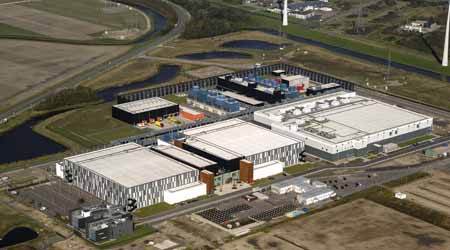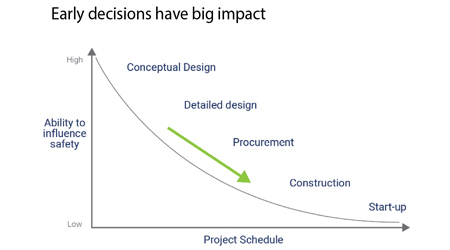 The demand for data processing capacity has led to the construction of large data centers and tightened schedules, potentially increasing safety risks.Aerovista Luchtfotografie / Shutterstock.com
The demand for data processing capacity has led to the construction of large data centers and tightened schedules, potentially increasing safety risks.Aerovista Luchtfotografie / Shutterstock.comFor Data Centers, Design with Construction Safety in Mind
Designing data centers with the safety of construction workers in mind is a critical first step to reducing construction-related incidents.
How can data centers be built more efficiently while still promoting the safety of every worker? Designing with safety in mind is the first step. Proactively influencing safety in the design phase is exponentially easier and more effective than trying to manage hazards in the construction and start-up phases.
Design modification can start with something as simple as standard symbols and abbreviations. By investing in these standardizations once and including them in every construction document, architects and engineers can easily mark hazardous or limited-access areas. Adding phasing and hazard nomenclature to a design takes minutes and creates a more effective and safe foundation for project implementation. This simple step ensures that subcontractors and personnel have appropriate training and commensurate experience to safely and efficiently perform the scope of work.
Standardizing details with fabrication and off-site construction in mind is another option. There are numerous safety benefits to incorporating off-site and modular construction. By relocating and streamlining processes that technology companies typically complete in the field, modular construction practices greatly reduce risks, especially those associated with work at elevation or in trenches. Items ranging from tilt-up walls to entire electric rooms can be built to specification off-site and shipped nearly completely assembled, offering a blend of controlled environmental conditions, duplicatable processes, and supply-chain and warehouse accessibility. Relocating construction activity also cuts down on on-site labor, reducing or even eliminating high-risk activities where labor would otherwise take place above or below another team or trade.
Another tactic is to migrate entry-level positions to a central, off-site location. This shift creates a safer training setting that can virtually eradicate the first-year onsite danger statistics and maximize both safety and education prior to field deployment. Operations will benefit from the unified team setting and the climate‑controlled location with ergonomic work surfaces. Controlled, repetitive work performed in a regulated off-site environment with fewer hazards and distractions will naturally increase performance and safety.

(Proactively influencing safety in the design phase is far easier and more effective than trying to manage hazards in the construction and start-up phases.)
Related Topics:















